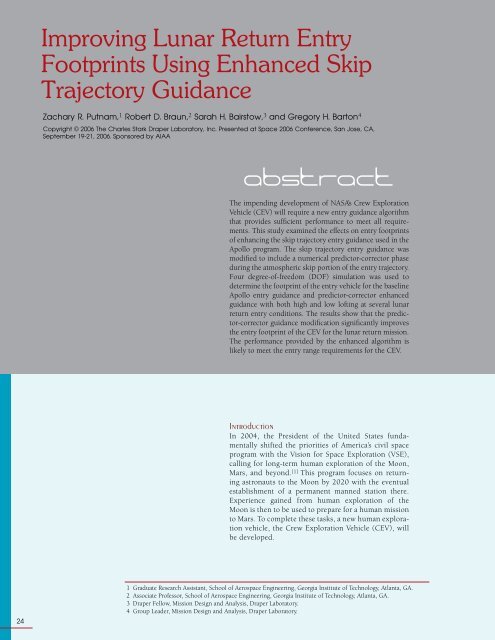Each - Draper Laboratory
Each - Draper Laboratory
Each - Draper Laboratory
You also want an ePaper? Increase the reach of your titles
YUMPU automatically turns print PDFs into web optimized ePapers that Google loves.
24<br />
Improving Lunar Return Entry<br />
Footprints Using Enhanced Skip<br />
Trajectory Guidance<br />
Zachary R. Putnam, 1 Robert D. Braun, 2 Sarah H. Bairstow, 3 and Gregory H. Barton 4<br />
Copyright © 2006 The Charles Stark <strong>Draper</strong> <strong>Laboratory</strong>, Inc. Presented at Space 2006 Conference, San Jose, CA,<br />
September 19-21, 2006. Sponsored by AIAA<br />
abstract<br />
The impending development of NASA’s Crew Exploration<br />
Vehicle (CEV) will require a new entry guidance algorithm<br />
that provides sufficient performance to meet all requirements.<br />
This study examined the effects on entry footprints<br />
of enhancing the skip trajectory entry guidance used in the<br />
Apollo program. The skip trajectory entry guidance was<br />
modified to include a numerical predictor-corrector phase<br />
during the atmospheric skip portion of the entry trajectory.<br />
Four degree-of-freedom (DOF) simulation was used to<br />
determine the footprint of the entry vehicle for the baseline<br />
Apollo entry guidance and predictor-corrector enhanced<br />
guidance with both high and low lofting at several lunar<br />
return entry conditions. The results show that the predictor-corrector<br />
guidance modification significantly improves<br />
the entry footprint of the CEV for the lunar return mission.<br />
The performance provided by the enhanced algorithm is<br />
likely to meet the entry range requirements for the CEV.<br />
Introduction<br />
In 2004, the President of the United States fundamentally<br />
shifted the priorities of America’s civil space<br />
program with the Vision for Space Exploration (VSE),<br />
calling for long-term human exploration of the Moon,<br />
Mars, and beyond. [1] This program focuses on returning<br />
astronauts to the Moon by 2020 with the eventual<br />
establishment of a permanent manned station there.<br />
Experience gained from human exploration of the<br />
Moon is then to be used to prepare for a human mission<br />
to Mars. To complete these tasks, a new human exploration<br />
vehicle, the Crew Exploration Vehicle (CEV), will<br />
be developed.<br />
1 Graduate Research Assistant, School of Aerospace Engineering, Georgia Institute of Technology, Atlanta, GA.<br />
2 Associate Professor, School of Aerospace Engineering, Georgia Institute of Technology, Atlanta, GA.<br />
3 <strong>Draper</strong> Fellow, Mission Design and Analysis, <strong>Draper</strong> <strong>Laboratory</strong>.<br />
4 Group Leader, Mission Design and Analysis, <strong>Draper</strong> <strong>Laboratory</strong>.

















